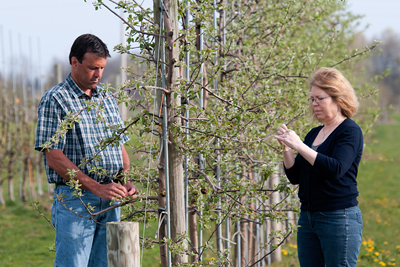New ag research funding model gains momentum
By Kate Frazer

Every dollar invested in agricultural research produces an estimated $10 in economic returns and helps feed a growing population, according to the U.S. Department of Agriculture's Economic Research Service.
Thomas Burr, associate dean of Cornell’s College of Agriculture and Life Sciences (CALS) and director of the New York State Agricultural Experiment Station (NYSAES), appealed to growers to make an investment in the future of their industries at a panel discussion at the Empire State Fruit and Vegetable Expo in Syracuse, N.Y., Jan. 22.
Burr and others hope a new funding model will bring together grower organizations and the New York state government to ensure that Cornell and other institutions have the capacity to do research essential to the state’s farm and food businesses.
“Farm commodity production, including all crop and livestock production sectors, is worth about $4.5 billion,” Burr said. “But when you add in related industries that supply seeds, fertilizer and equipment, plus food and beverage establishments that depend on local agriculture, the total soars to $96.3 billion. Agricultural research supports that bottom line.”
Considering new funding models is necessary in light of shrinking public funding of agricultural research, he said. State funding has dropped nearly 30 percent in New York over the past five years, while federal spending has been stagnant for years, and is regressing when inflation is considered.
Burr explained how these reductions hinder the ability of CALS and other institutions to provide the assistance-on-demand growers are accustomed to, pointing to this summer’s spotted wing drosophila invasion as an example. The population of this tiny pest exploded in New York in August, forcing many berry growers to close their fields and abandon the crop. In response, Cornell initiated five local and regional research projects to determine what crops are most at risk and develop approaches to combat the interloper.
“When problems like this arise in agriculture, a rapid and effective response requires ready-to-go expertise,” said Burr. “You have to act immediately.”
The response among those who braved blowing snow and freezing temperatures to participate in the evening discussion was enthusiastic.
Panelists noted that agricultural research is about new opportunities, as well as threats, citing economic returns from new orchard management practices and new varieties that were made possible when the New York Apple Research and Development Program doubled its investment in research.
“Research is what has driven this industry and kept us moving forward,” said Darrel Oakes, owner of LynOaken Farms in Lyndonville, N.Y. “Spending on research leads to improved technology, which leads to lower costs and higher production.”
“When I was a lawyer, I had to pay for every bit of research I wanted,” added Randy Pratt, owner of Wilkens Fruit and Fir Farm in Yorktown Heights. “But as a grower, I contribute just pennies. We have to do more. The money just isn’t there at state and federal levels.”
Burr says the commitment of private grower groupsto invest in research is a bright light, and he envisions a model that would scale up these groups’ investments and ensure they are matched by the state.
Funding research can be challenging for growers, whose earnings can vary dramatically season to season, but Craig Yunker, managing partner at Batavia Turf and CY Farms, said it is worthwhile – and urgent.
“The state needs it for economic development, our land-grant universities need it and the world needs it,” Yunker said. “There’s nothing more important for feeding New Yorkers and the world.”
Kate Frazer is the agricultural stations communications officer for the College of Agriculture and Life Sciences.
Media Contact
Get Cornell news delivered right to your inbox.
Subscribe